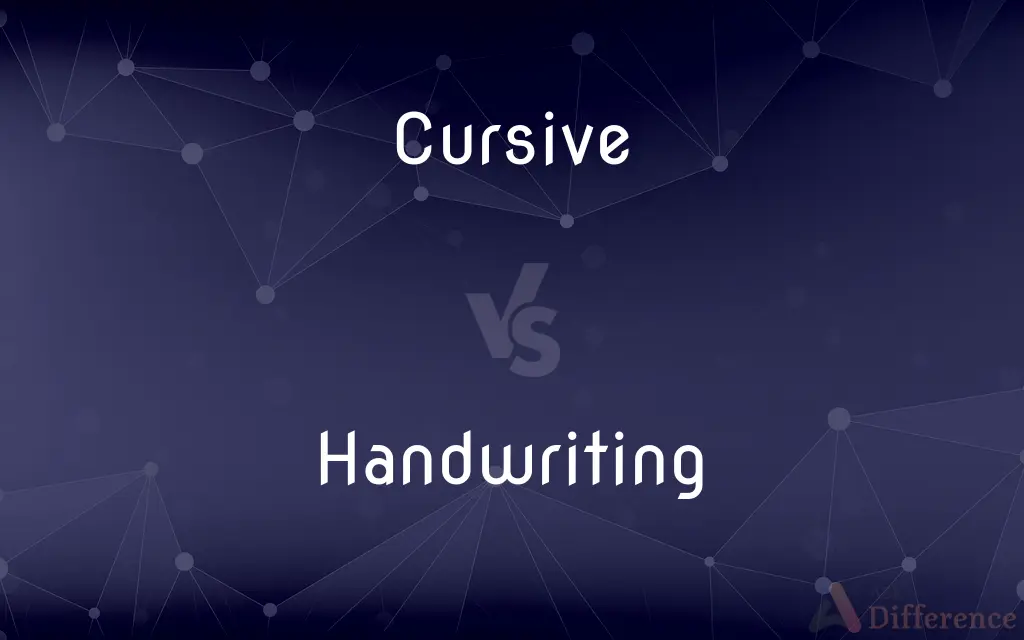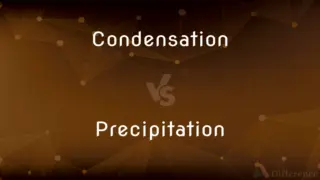Cursive vs. Handwriting — What's the Difference?
By Fiza Rafique & Maham Liaqat — Updated on April 6, 2024
Cursive writing connects letters with flowing strokes for faster writing, while handwriting encompasses all forms of writing by hand, including print and cursive.

Difference Between Cursive and Handwriting
Table of Contents
ADVERTISEMENT
Key Differences
Cursive writing is a style of penmanship where letters are connected in a flowing manner, often used to facilitate faster writing. Whereas, handwriting refers to the individual's unique style of writing with a pen, pencil, or other tools, encompassing both printed and cursive styles.
Cursive is specifically designed to be written more quickly than print because of its flowing, connected letters. On the other hand, print handwriting emphasizes clarity and simplicity, with each letter standing alone without connections to others.
One of the main features of cursive writing is its emphasis on speed and efficiency, allowing for faster note-taking and writing. In contrast, handwriting in print form can be slower but is often more legible to those unaccustomed to reading cursive.
Cursive writing requires learning specific strokes for connecting letters, which can improve fine motor skills and penmanship. Handwriting, especially in print, might be easier for beginners to learn and master due to its straightforwardness.
Despite the decline in teaching cursive in some educational systems, it remains a valuable skill for its aesthetic appeal and historical significance. Conversely, mastering general handwriting skills, including print, remains essential for effective communication and personal expression.
ADVERTISEMENT
Comparison Chart
Definition
Style of penmanship where letters are connected
Any form of writing done by hand
Speed
Generally faster due to connected letters
Can vary, print is usually slower
Legibility
Can be less legible to those not accustomed to it
Generally more legible, especially in print form
Learning Curve
Requires learning specific connecting strokes
Easier for beginners, especially in print form
Usage
Often used for personal notes, signatures
Used in all forms of hand-written communication
Compare with Definitions
Cursive
A variant of cursive writing characterized by large loops and links, making it elegant and often used in formal invitations.
The wedding invitations featured the guests' names written in beautiful looped cursive.
Handwriting
Handwriting that is clear and easy to read, regardless of whether it is in print or cursive form.
His legible handwriting made his exam answers easy for the teachers to grade.
Cursive
Cursive handwriting that is consistently angled or slanted, typically to the right, for aesthetic and legibility purposes.
Her slanted cursive added a personal touch to her handwritten notes.
Handwriting
A person’s name written in cursive as a form of identification or authorization on documents.
The document was official once it bore his cursive signature at the bottom.
Cursive
A style of handwriting where letters are fluidly connected in a flowing sequence to facilitate faster writing.
She practiced her cursive writing until she could smoothly connect all the letters.
Handwriting
A style of handwriting where letters are written separately in their block form, known for its clarity and legibility.
The teacher insisted on print handwriting to ensure that all students could read the notes.
Cursive
This form of cursive writing emphasizes the continuous flow between letters, with minimal lifting of the writing instrument.
His connected cursive was so smooth that his pen barely left the paper.
Handwriting
The study of a person's writing style and patterns to infer characteristics about the writer, also known as graphology.
Handwriting analysis revealed his meticulous nature through his precise and neat writing.
Cursive
Cursive (also known as script, among other names) is any style of penmanship in which some characters are written joined together in a flowing manner, generally for the purpose of making writing faster, in contrast to block letters. Cursive handwriting is very functional, and is intended to be used in everyday writing.
Handwriting
The unique way an individual writes, combining elements of both print and cursive or exhibiting unique characteristics.
Her personal handwriting style was a mix of print and cursive, making her notes distinctive.
Cursive
Having the successive letters joined together
Cursive writing.
A cursive style of type.
Handwriting
The act or technique of writing with the hand, using a writing instrument, including styles such as print or cursive.
Despite the digital age, her handwritten letters held a personal charm.
Cursive
A cursive character or letter.
Handwriting
Handwriting is the writing done with a writing instrument, such as a pen or pencil, in the hand. Handwriting includes both printing and cursive styles and is separate from formal calligraphy or typeface.
Cursive
A manuscript written in cursive characters.
Handwriting
Writing with a pen or pencil
This method of duplicating can reproduce typewriting, handwriting, or drawings
Cursive
(Printing) A type style that imitates handwriting.
Handwriting
Writing done with the hand.
Cursive
Running; flowing.
Handwriting
The writing characteristic of a particular person.
Cursive
(of writing) Having successive letters joined together.
Handwriting
The act or process of writing done with the hand, rather than typed or word-processed.
Cursive
(grammar) Of or relating to a grammatical aspect relating to an action that occurs in a straight line (in space or time).
Handwriting
Text that was written by hand.
Cursive
(countable) A cursive character, letter or font.
Handwriting
The characteristic writing of a particular person.
Cursive
(countable) A manuscript written in cursive characters.
Handwriting
(by extension) A characteristic trait or hallmark by which somebody may be recognised.
Cursive
(uncountable) Joined-up handwriting.
Handwriting
Present participle of handwrite
Cursive
Running; flowing.
Handwriting
The cast or form of writing peculiar to each hand or person; chirography.
Cursive
A character used in cursive writing.
Handwriting
That which is written by hand; manuscript.
Cursive
A manuscript, especially of the New Testament, written in small, connected characters or in a running hand; - opposed to uncial.
Handwriting
Something written by hand;
She recognized his handwriting
His hand was illegible
Cursive
Rapid handwriting in which letters are set down in full and cursively connected within words without lifting the writing implement from the paper
Handwriting
The activity of writing by hand;
Handwriting can be slow and painful for one with arthritis
Cursive
Having successive letter joined together;
Cursive script
Common Curiosities
Can everyone read cursive writing?
Not everyone, especially younger generations or those not taught cursive, may find it challenging to read.
What is cursive writing?
Cursive is a style of handwriting where the letters are connected, intended to make writing faster and more efficient.
Do people still use cursive for anything?
Yes, it's still used for personal notes, signatures, and by those who prefer its aesthetic.
Is handwriting only in print form?
No, handwriting encompasses both print and cursive styles.
Why is cursive less common now?
The decline in teaching cursive in schools and the rise of digital communication have made it less common.
What are the benefits of learning cursive?
Benefits include improved writing speed, fine motor skills, and a unique personal style.
How does handwriting differ from cursive?
Handwriting includes all forms of writing by hand, such as print and cursive, whereas cursive specifically refers to connected letters.
Is cursive writing faster than print handwriting?
Yes, cursive is generally faster than print because the letters are connected, reducing pen lifts.
Is print handwriting easier to learn than cursive?
Generally, yes, because print letters stand alone and don't require learning connections between letters.
Is cursive considered more formal than print?
Historically, yes, but in modern contexts, the distinction has lessened.
Are there different styles of cursive writing?
Yes, there are several styles, such as D'Nealian, Zaner-Bloser, and Palmer, each with unique characteristics.
Does using a specific writing instrument affect handwriting style?
Yes, the choice of pen or pencil can influence the ease of writing and the appearance of handwriting.
Can cursive writing improve handwriting quality?
It can for some, as it encourages a fluid motion and often a more uniform appearance.
How does one transition from print to cursive handwriting?
By learning the specific strokes that connect letters and practicing regularly.
Why is legibility important in handwriting?
It ensures the written message can be easily read and understood by others.
Share Your Discovery

Previous Comparison
Sable vs. Stoat
Next Comparison
Condensation vs. PrecipitationAuthor Spotlight
Written by
Fiza RafiqueFiza Rafique is a skilled content writer at AskDifference.com, where she meticulously refines and enhances written pieces. Drawing from her vast editorial expertise, Fiza ensures clarity, accuracy, and precision in every article. Passionate about language, she continually seeks to elevate the quality of content for readers worldwide.
Co-written by
Maham Liaqat














































